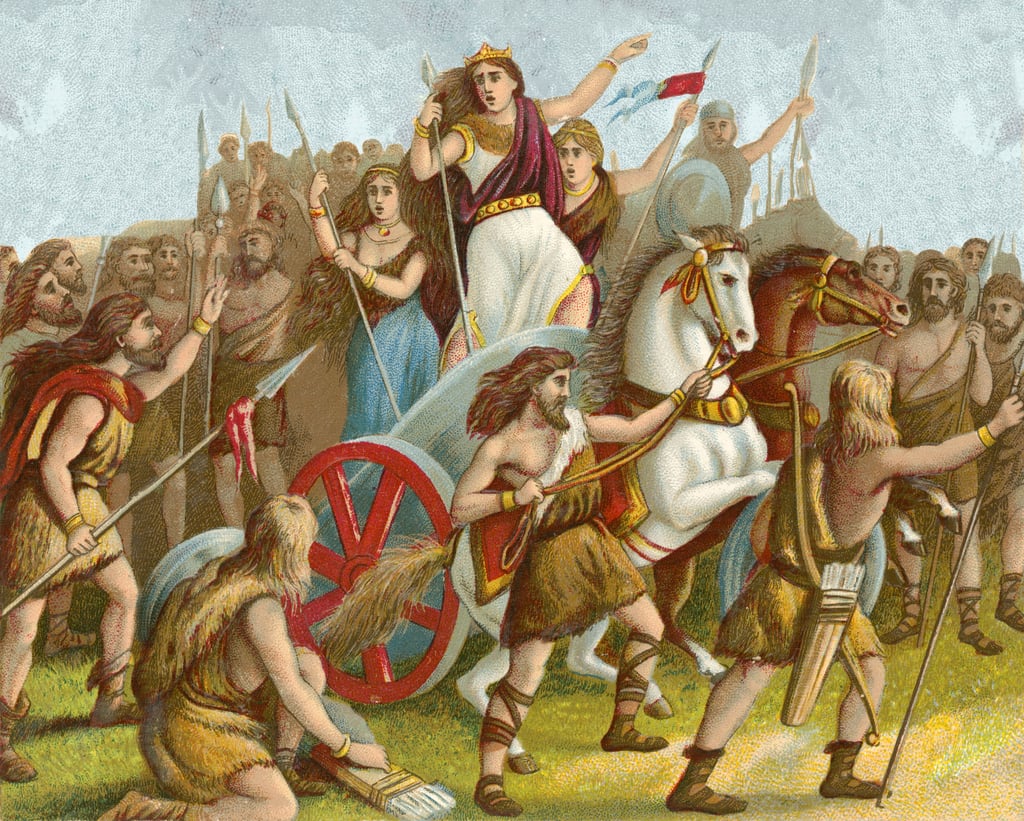After the sack of London, Boudica and her war host moved north along Watling Street towards Verulamium, the Roman town outside the modem St Albans in Hertfordshire. Unlike the other two centres, Camulodunum and Londinium, this was entirely a British settlement that served as the capital of the Catuvellauni. Yet it was as thoroughly and savagely destroyed as the other two.
The Growth of Verulamium (St Albans)
Like Colchester, Verulamium was a settlement with an important late iron age predecessor. Pre-Roman Verulamium is known as VerIamion, after the spelling of the place found on coins of Tasciovanus, who reigned from c.15 BC to c.AD 10.
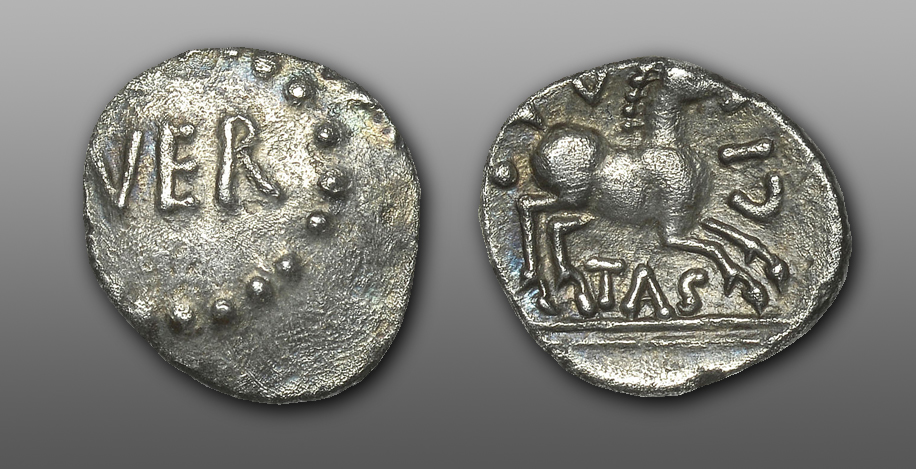
A series of larger and smaller earthwork ramparts with outer ditches defended the settlement. Some mark out the sites of individual farmsteads, while others demarcate whole tracts of the countryside. Pollen analysis shows the landscape was only sparsely wooded, with most of the land devoted to pasture and arable cultivation. Finds of Iron Age coin moulds are widely spread across the site of the later Roman town. They concentrate around a small rectilinear ditched enclosure beneath the site of the later forum and basilica complex; it is possible this was the site of a royal residence or mint. A large cremation cemetery in use from c.AD 60 at King Harry Lane, with a wealth of material imported from the Roman world, testifies to the high standard of living and far-flung connections of the population. A more chilling find is a skull fragment from a house in Insula XII (an insula was one of the blocks into which a Roman town was divided), a reminder of the head hunting practise on iron age Briton.
Such was the importance of Verlamion that when the Romans built the main road that linked London and the Midlands, Watling Street, it was routed through the town.
By the late 40s AD, iron age Verlamion was transforming itself into Roman Verulamium, a settlement on more truly urban lines It did this spontaneously, with minimal Roman input. This early progress at Verulamium so impressed the Romans that it was created a municipium, a class of urban site second only instatus to a colonia like Colchester, with privileges bestowed on it by law.
Like ruin fell on the town of Verulamium, for the barbarians, who delighted in plunder and were indifferent to all else, passed by the fortresses with military garrisons, and attacked whatever offered most wealth to the spoiler, and was unsafe for defence. About seventy thousand citizens and allies, it appeared, fell in the places which I have mentioned. For it was not on making prisoners and selling them, or on any of the barter of war, that the enemy was bent, but on slaughter, on the gibbet, the fire and the cross, like men soon about to pay the penalty, and meanwhile snatching at instant vengeance.
Tacitus: Annals: Book Fourteen: XXXIII Londinium (London) and Verulamium (St Albans) follow
Understandably the architecture of early Verulamium was a blend of native and Roman. Many of the buildings were rectangular structures built on timber sleeper beams in iron age style; occasionally post-built structures are found. Roman influence is apparent in Insula XIV, where a terrace of rectilinear buildings was fronted by a colonnaded walkway, the whole block being best interpreted as a row of shops owned by an entrepreneur who leased out individual premises. Elsewhere two other early buildings destroyed by Boudica were built in masonry, a Roman innovation.
Verulamium is razed to the ground
Verulamium was no match for the Boudican hordes. Like Colchester and London, it was razed to the ground. Sites with burnt layers from its sack are concentrated in the heart of the later city. Their geography is important because they indicate the extent of the town in AD 60. It emerges that Verulamium extended over only some 8 hectares, far smaller than used to be thought, but much more in keeping with the size of contemporary towns. The public bath house, built of flint and mortar, survived and was later repaired.
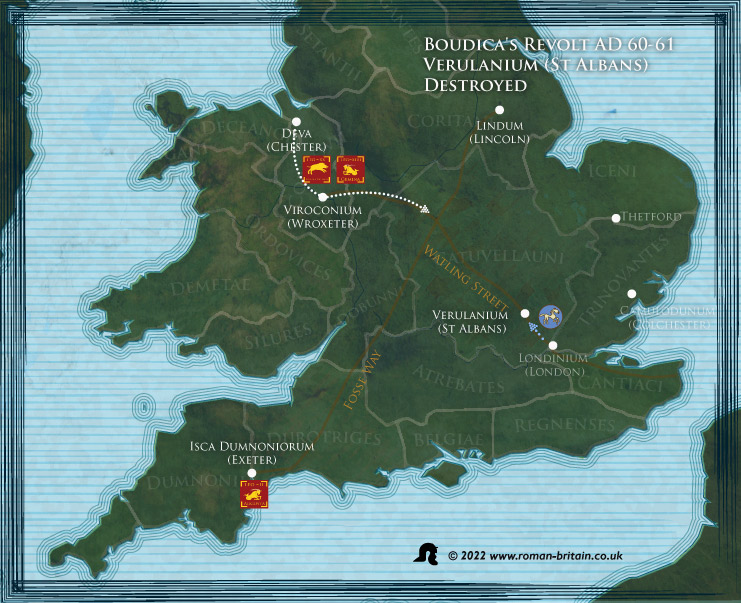
Boudican Destruction horizon at Verulamium
At Verulamium the Boudican destruction horizon consists of the same clean red daub and ash found at London and Colchester, ranging here up to a maximum of about 50 centimetres, in Insula XVII. Unlike London and Colchester, the destruction of standing structures was not total. Some buildings in the south-west comer of Insula XIV escaped, as well as some of the outbuildings of the shops in the opposite, north-east corner of the same insula, which fronted Watling Street, even though the shops themselves were burnt. Evidently the shops had been set alight from the Watling Street side by arsonists at a time when the wind was blowing from the south-west. One of the shops sold samian ware, to judge by the thirty-seven unused vessels spilled across the veranda fronting the street. In another shop were the burnt remains of a water tub set in the ground; it had filled with burnt daub and the carbonised sides of the tub could be seen rising above the floor level. Two complete pots stood on the floor of another room; when the buildings were torched they had filled with burnt daub. Nearby was a pit which held a chest filled with textiles. A lump of bronze drapery from the same insula in a context dated c.AD 75-85 must be scrap collected from the destruction of a statue in AD 60. The character of the destruction horizon at Verulamium differs from that of London and Colchester by the absence of any parcels of coins or burnt grain deposits. Although this might reflect the thoroughness with which the town was looted, the likelihood instead is that at least some of the inhabitants escaped with their portable belongings.
Destruction was not confined to the town of Verulamium. 5 kilometers south east of the town centre, a house at Park Street was destroyed in the revolt. When it was burnt down, it left a spread of burnt daub over a clay floor. Park Street is only 475 metres east of Watling and would have been an easy target for the Boudican war band using the road as it advanced on Verulamium. At Gorhambury, 2 kilometres to the north-west of Verulamium, another farmstead was destroyed in the revolt. Gorhambury was a large rectangular enclosure defended by a ditch and rampart; inside there were two rectangular buildings and one round house. These sites were not the homes of Roman oppressors, but homesteads of the native population. Their destruction shows that existing ethnic hatred — in this case Trinovantian resentment at their conquest by the Catuvellauni under king Cunobelinus — was a significant ingredient in the revolt, a factor overlooked in antiquity by historians of the revolt.
The Hockwold Treasure
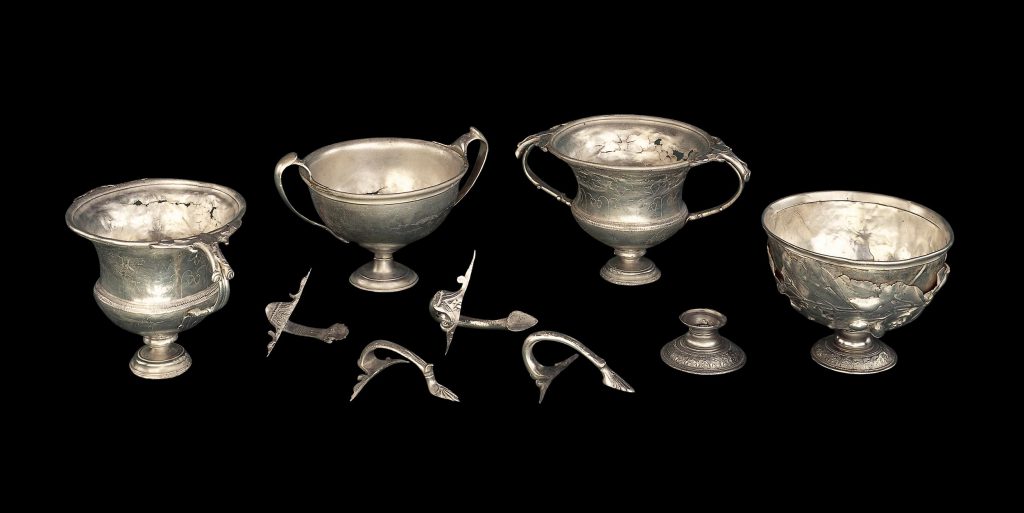
A hoard of seven silver Roman cups and handles discovered in 1962 at Hockwold in Norfolk. The cups were found crushed and dismantled, and have been carefully reconstructed by the British Museum where they are on display. One cup is decorated in relief with vine leaves and olives, and two other cups have engraved Bacchic motifs.
Could they have been loot from the sack of Camulodunum? The cache is obviously loot and, although it cannot be precisely dated, falls into the early post-Conquest period. These fine wine cups and bowls might well have graced the table of a wealthy colonist. It would be difficult to place them in an earlier historical context, unless they were from the royal Icenian household, hastily buried when the Roman soldiers treated Boudica and her daughters with such indignity and contempt. But it is too small a cache for this, and is more likely to have been the result of theft or loot.
Hawkedon Helmet
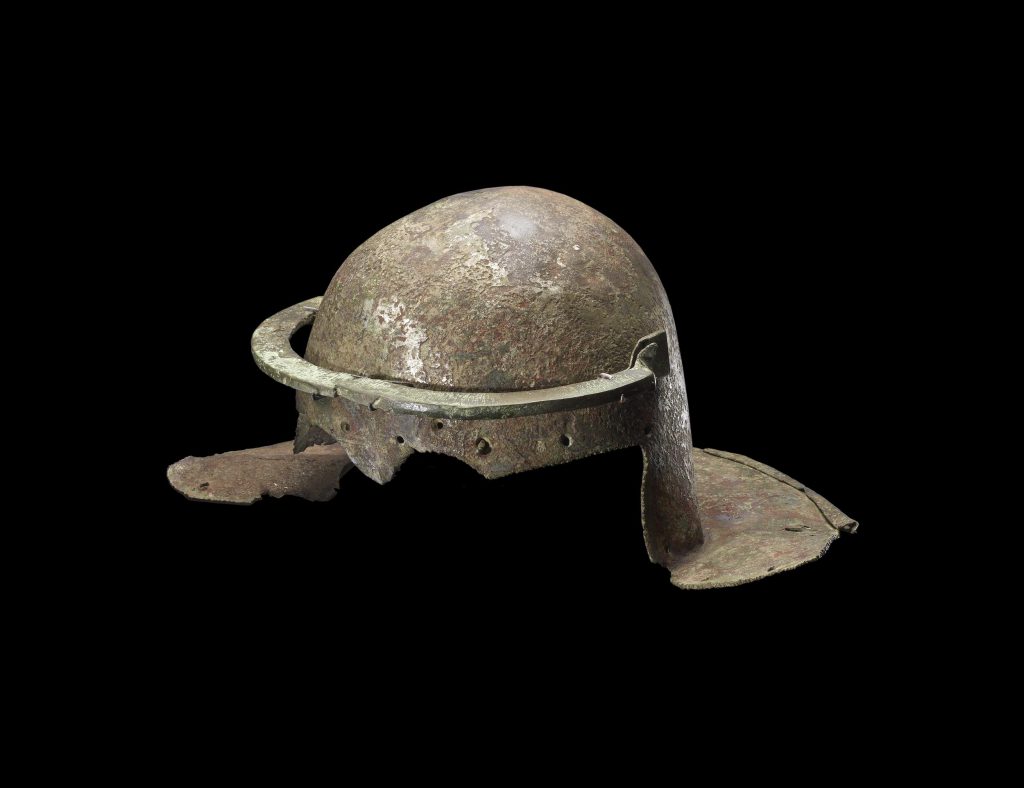
In April 1965 a Roman helmet was ploughed up at Hawkedon, Suffolk, some ten miles north of Lavenham which is now in the British Museum.
It is of thick bronze with traces of tinning on the surface and weighs over five and a half pounds. Its weight and appearance identify it as a helmet used by gladiators, not for fighting in the arena, but for practice. The weight of the helmet—more than twice tile weight of the heaviest of three first-century legionary helmets in the British Museum.
The helmet has received severe damage on the right-hand side, as if from a heavy blow. Evidence of gladiators in Britain is not very strong, but their portrayal on glass, pottery and mosaics shows that they must have been popular, although of course their use in Britain may have been limited. The nearest arena would have been at the veteran settlement at Colchester, where games and shows must have been regular events, associated with the ritual of the Imperial cult centred in the great temple dedicated to the deified Claudius. The helmet was probably looted from the colonia stores and could even have been used in battle by one of the Britons.
